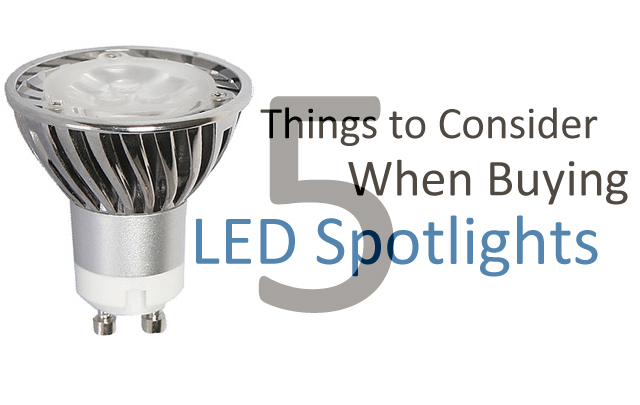5 Important Things To Consider When Buying LED Spotlights
Posted by Amit Soni on 9th Aug 2013

You’re considering replacing all of your inefficient halogen spotlight bulbs with bang up-to-date, energy-saving LED lights, but it’s a relatively new technology to you, so here are 5 of the most important things to think about, prior to making your purchases:
1. Mains Voltage Or Low Voltage?
To put it another way, do you need spotlights with mains-voltage capability like GU10 LEDs? Or instead, do you require low voltage MR16 fittings?
If you’re replacing low-voltage halogen bulbs, you’ll need to upgrade your transformer to an LED-compatible driver. Alternatively, you can convert your existing light fittings from MR16 to GU10, using our pack of 5 x GU10 Lamp Holders. By doing so, you’ll completely remove the need for a transformer and will no longer have to worry about compatibility.
2. Warm White, Cool White Or Daylight White?
With LED spotlight bulbs there’s a choice of colour temperatures. This great feature will enable you to tailor the lighting ambience of your room or space according to its purpose or the mood you wish to create within it.
- The warm white (3000K) casts a soft, halogen-like glow, and is suitable for living areas such as the lounge, hallway and bedroom.
- The cool white (6000K) is a bright, clear light, most often used in functional rooms like kitchens and bathrooms, or to accent the features of a room.
- The daylight white (4000K) is the most naturalistic of the colour temperatures and, as such, is perfect for all environments, especially those like the office, or for art studios and retail outlets.
3. Wide Beam Or Narrow Beam?
This is dependent upon where the bulb is going to be located, and its application once installed. For example, if the bulb is being used for general illumination, you may want to choose a spotlight with a beam angle that’s fairly wide, as this will create a nice even coverage. LED spotlight bulbs can reach up to 120° so they’ll be perfect for this type of use.
Conversely, if you’re illuminating a piece of artwork or the bulbs are to be installed in a multi-directional LED ceiling spotlight fitting, you may decide to choose a bulb with a narrower 38° to 60° beam angle. These spotlight bulbs will be more focused and you’ll have more control over the light placement.
4. The Size Of The Bulb
While most modern light fittings are manufactured to accommodate bulbs that measure 50mm by 50mm, similar dimensions to those of a traditional GU10 halogen, not all LED bulbs are the same size, so it’s important to check the size of your LED spotlights prior to making your purchase, otherwise you may find they don't fit.
Generally speaking, the more powerful the LED bulb, the greater its size will be. The reason for this is that powerful LED bulbs require larger heat sinks, which in turn increase the dimensions of the bulb. The heat sink is an essential component of an LED bulb, and one of the many reasons for their superiority over the halogens they’ll replace. It dissipates any heat the bulb may generate, effectively ensuring its incredibly long 50,000 hour life-expectancy.
5. Dimmable Or Non-Dimmable?
Do you require dimmable or non-dimmable LED spotlight bulbs? One of the many myths that have built up around LED bulbs is that they’re not dimmable. They are, provided you purchase the correct models, and use them in conjunction with a trailing edge dimmer switch. It’s important to note that conventional leading edge dimmer switches require a much higher electrical load than low-voltage, energy-efficient LED bulbs are designed to handle, so they won’t be compatible.
LEDs such as one of the dimmable GU10 LED bulbs won’t only enable you to control the intensity of the light they emit, they’ll also save you a substantial amount of money, because you’ll decide how much or how little electricity they use.
Not only that, but the considerably-reduced energy requirement of LEDs, as opposed to traditional halogens, will cause your electricity expenditure to fall drastically as well. The aforementioned GU10 LED bulb, for example, requires just 4 watts of electricity to provide the same number of lumens as a 50 watt halogen, meaning that it’s over 90% more energy-efficient.
Replace just 1 x 50 watt halogen bulb with a 4 watt LED, and you’ll be looking at savings of £18.47 over the course of a year, based on an 8 hour working day and assuming an electricity cost of 13.75 pence per kW/h.
So just imagine the savings you could make by replacing all your inefficient halogen bulbs with incredible, energy-saving LEDs!
Hopefully, these handy tips will enable you to make a more informed choice when you’re purchasing LED spotlight bulbs, but if you do require any more information, please don’t hesitate to call one of our specialist advisors on 0116 321 4120.
You can also check out the entire range of LED spotlights here or, if you’d prefer, send us an e-mail enquiry to: cs@wled.co.uk.





